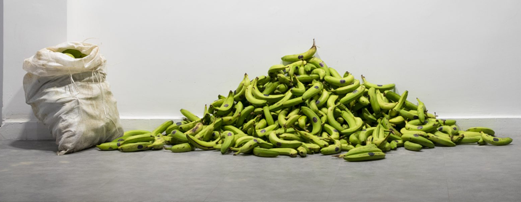Banana Craze unites nine contemporary artists whose work examines the banana production of Caribbean and Latin American countries. As the fourth most important food crop in the world, the banana dominates food production in Latin America where they are grown on large mono-crop plantations mostly run by three multi-national corporations. These works range from investigations of human-rights violations, recordings of lost biodiversity, and highlights of the effects of pesticides on health and environment, to a satirical reenactment of the origins of the banana monoculture. The works in this exhibition bear evidence in a stinging indictment against those who have acted in the interest of profit over humanity, resulting in profound inequities between producers and consumers.
The artists in Banana Craze reflect on the dramatic footprint that the banana industry has left in both the natural and social ecosystems of banana producing nations since the beginning of the 20th Century until today. Exhibiting artists include María José Argenzio, Julián Chams, Claudia Claremi, Milko Delgado, Óscar Figueroa Chávez, Leonardo González, Rachelle Mozman Solano, Daniela Serruya Kohn, and the research agency Forensic Architecture in collaboration with The Truth Commission. Banana Craze is curated by Dr. Juanita Solano and Dr. Blanca Serrano.
Cultivate
Showing concurrently, Cultivate features the work of seven Colorado-based artists exploring food insecurity and access in Colorado. The exhibition was inspired by Sammy Lee’s paper-skin mural titled Bolt Down: our narrative of food insecurity and its representation of data collected by the Colorado Health Institute. Using her signature technique of felting and casting paper, Lee Illustrates the shocking lack of food security faced by Colorado residents, especially young adults.
Eileen Roscina uses her installation titled Uneaten to address the inefficiency and wastefulness of the United States’ food system. Roscina highlights the struggle of millions of Americans to afford adequate food while the equivalent of 130 billion meals of food ends up in the garbage yearly. In addition, Cherish Marquez’s work points to the struggle to find healthy food in her animation of a food desert, a situation found in many communities in Colorado with low access to grocery stores.
As a counterpoint to food insecurity and unjust access, artists Tsehai Johnson and Heather Link-Bergman question our food choices. Through an installation of handmade tableware, Johnson encourages viewers to discover and use the edible “weed” plants that commonly grow unassisted in our neighborhoods. While Heather Link-Bergman uses collaged food advertisements to explore the impact of food trends and to question the gains and losses of these obsessions.
Artists Viviane Le Courtois and DesertArtLAB (artist duo April Bojorquez and Matt Garcia) approach their work with an eye toward creative solutions. Using handmade porcelain planters, Viviane Le Courtois grows edible plants in her installation, demonstrating the ease of cultivating food at home. DesertArtLab inspires with their ongoing Land Art work “The Desert Cookbook”. Using an urban desert field site in Pueblo, CO, DesertArtLab teaches ancient food practices used by indigenous communities living in arid regions.
Cultivate celebrates these local artists who examine our food systems with a critical eye and rally around a thoughtful approach to food production. Artists include DesertArtLAB (April Bojorquez and Matt Garcia), Tsehai Johnson, Viviane Le Courtois, Sammy Lee, Heather Link-Bergman, Cherish Marquez, and Eileen Roscina. Cultivate was curated by CVA Director and Curator Cecily Cullen.
For more information, visit Metropolitan State University Denver Center for Visual Art.



